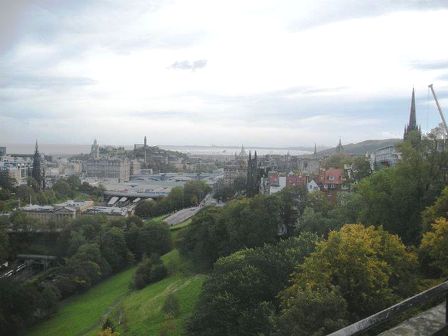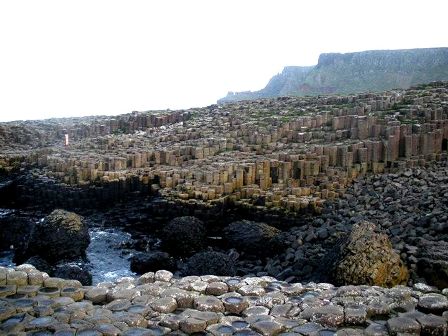Getting Out of London
Even though London is a great, amazing, fantastic city, as with any big city it is loud, busy, and full of people (specifically tourists who will not move even after you ask them politely in five different languages). For these reasons, sometimes it can be nice to get out of London and find some place quieter. These are just a few of the places I have travelled over my time in the U.K., though by no means is it an exhaustive list of all the places you can travel in the U.K.
Edinburgh
First on my list is Edinburgh. It is probably my favorite city in the U.K. outside of London, and it is one of the first places I visited when I came to here as a child. Edinburgh is a city rich in history and natural beauty, just make sure you pronounce it correctly and never say Edin-burg to a Scot.
The first place you should go is Arthur’s Seat. It is a gigantic hill that offers a breathtaking panoramic view of the entire city. The hike up is quite a trek but well worth it in the end. After descending down to the bottom of the hill, you can visit the Scottish Parliament. A product of devolution, the building cost £431 million dollars to complete (roughly 10 times over the budget). Personally, I am not a fan of modern architecture or this building. Though to be fair, I may just be biased to my old office at Westminster, which is pretty difficult to compete with. The Palace of Holyroodhouse, which is the official resident of the Queen in Scotland, is located right across from the parliament building. The palace is open to visitors during different times of the year.
From the palace, most people travel up the Royal Mile, the main street through the old town. It is lined with numerous shops and pubs popular with tourists. At the top of the Royal Mile upon a tall hill lies Edinburgh Castle. The fortress-designed castle has been there since roughly the early middle ages. The castle contains the Crown Jewels of Scotland and the infamous Stone of Destiny. The stone was used in the coronations of Scottish kings until the English King Edward I took it as a spoil of war. The English (the British) kings have used it at every coronation since then. It was briefly stolen in the 1950s by a group of Scottish students but later returned to Westminster Abbey, until finally the British Government finally decided to return the stone to Scotland in 1996. Overall, the castle is one of the key symbols of Edinburgh and no trip there is complete without a visit.

View of the city from Edinburgh Castle
Another thing you have to experience in Scotland is haggis. Haggis is a traditional Scottish dish made from sheep organs, fat, and spices cooked in the animal’s stomach. Travelling for me is all about going outside of your comfort zone and nothing is more outside my comfort zone than a strange assortment of meat cooked in stomach. I have tried it and if you can manage to ignore its contents, it essentially just takes like over-spiced meat.
Once you have gotten over the taste of meat cooked in stomach, you can visit the Elephant House Café where J.K. Rowling wrote many of the early Harry Potter novels. Another popular Edinburgh attraction are the numerous ghost tours that run throughout the city, including ones that navigate through the underground vaults of Blair Street. Scotland is also well known for its excellent whiskey. There are many whiskey bars in Edinburgh, but the most popular is probably the Scottish Whisky Experience. This place offers many different types of whiskey tasting, complete with tours around the facility where you can learn about different types of whiskey and how they are made. The Scottish Highlands can also make a nice side trip while visiting the city. The Highlands are beautiful and picturesque but they will take almost a full day to see, so do not plan on visiting here unless you have the time in your trip.

Me in the Highlands
Bath and Stonehenge
Most trips to the U.K. generally include a trip to Stonehenge. While I do think it is worth visiting, do not plan to spend an entire day there. Stonehenge and the history surrounding it are undoubtedly fascinating, but unless you plan to participate in the solstice celebrations or start an archeological dig, the trip around the circle will take about 30 minutes tops. Personally, I feel Stonehenge is one of those tourist attractions you go to just to say you have been there. Nevertheless, it is an amazing monument of early human history, and a must see if you have time in your trip. However, the best way to visit Stonehenge in my opinion is to do so in conjunction with a trip to Bath.
Bath is best known for two things: its ancient Roman baths and its connection to Jane Austen. The Roman baths are my favorite spot in the city. Built during the Roman occupation, later Brits thought the baths had healing powers and travelled to the city to cure their various ailments. The baths today still attract thousands of visitors a year and have an impressive museum detailing their history from the Romans to modern times. Bath’s other main attraction is the Jane Austen Centre. Ms. Austen lived in Bath for several years and the city has capitalized on its famous former resident by making a museum dedicated to her and providing Austen themed tours around the city to all of her favorite haunts.
The Great Bath
Bath Abbey is also worth a visit. Located next to the Roman baths, it is free to enter (though a small donation is suggested) and features a breathtaking vaulted ceiling. For those not willing to shell out the nearly £20 entry fee to Westminster Abbey, Bath Abbey is a good alternative. If you have any time left in your day, Bath has some lovely gardens to relax and have a picnic in, or you can merely wander around the city’s many narrow passageways and picturesque streets. As in London, Bath is one of those cities you could spend days wondering through without a care in the world.
Bath Beauty
Oxford
The first time I went to Oxford, I was 10 years old and everything looked like it was straight out of a Harry Potter novel, which is probably why they shot many of the movies there. When I went back earlier this summer, it felt exactly the same. One of the easiest day trips from London, it takes only an hour or so to get there. The first thing to do when you arrive should be simply to walk around and marvel at the beauty and history that is Oxford. The city is at once charming yet over-whelming in the weight of its history. The colleges here have educated some of the greatest minds in both British and world history. My personal favorite attractions were the libraries of each college, originally built as fortresses to protect the books. The most famous of which is probably Radcliffe Camera. Next, I recommend visiting the Oxford Covered Market. The market features a collection of fresh food, knick-knack, and clothing vendors. Make sure to grab one of the milkshakes at Moo-Moo’s, where you can have any flavor you can imagine from Toblerone to Rose Syrup. While enjoying said milkshake you can take a stroll down part of the Thames through the park near Christ’s Church. The meadows around this park are so quintessentially British that one half expects Mr. Darcy to pop over the hill to declare his undying love to you, as if your life has become a Jane Austen novel. You can even rent a boat and float down the river to complete the literary dream.
My friend Lauren and I in Christ Church Meadow
To continue the literary theme you can make the trek across Oxford to visit the grave of J.R.R. Tolkien, though I only recommend this for the true Tolkien lover as the cemetery is quite far from the center of town. For those preferring a less eerie connection to the literary giants of Oxford’s past, you should visit The Eagle and the Child pub. An unassuming franchised pub, it is famous for being the favorite local watering hole of J.R.R. Tolkien and his friend C.S. Lewis. The pub still has a great deal of memorabilia connecting it to the two and a pint is always nice after a long day of walking. My final suggested spot is Turf Tavern, where former President Clinton, while attending Oxford as a Rhodes Scholar, supposedly “did not inhale.” Besides its political connection, the pub is also quite cute. To get to it you have to wander down a small winding alley, which finally opens up to the small pub surrounded by a charming terrace and lined by part of the old city wall. If you have time, grab a kebab on your way back to the train station to end your day (they are half the price of one’s in London).*
Penzance and St. Ives
Penzance and St. Ives are two coastal towns in Cornwall, in the south of the U.K., easily accessible by train from London. The first thing you see when approaching Penzance is St. Michael’s Mount, an small island connected to the mainland by a pathway across a narrow causeway that is only accessible for a couple hours a day when the tide is low (you can travel there by boat when the tide is high). On the island, there is a castle that dates back to medieval times. Interestingly, the National Trust owns the property but has leased it back to the original family for the next 999 years.
St. Michael's Mount
Penzance itself is a cute coastal town lined with a nice beach to lay out on, when the weather is warm. It is also noted for the gigantic Jubilee Pool, built in the 1930s. The pool is a nice place to go for a swim if you do not mind the other tourists. It is so large that people regularly kayak in it.
After about a day in Penzance, I recommend travelling to St. Ives to see more of Cornwall. Travelling there around the peninsula via the local bus is fairly inexpensive. It takes a while due to the number of stops but the ability to sit and see the beauty of the Cornish countryside makes the trip well worth it. If you have time, you should stop at Land’s End, the most southwestern point of England. The pathways along the cliffs are open to hikers, who can often see sharks, seals, and dolphins swimming in the aqua blue water below. Admission is free; there is only a small fee if you need to park a car.
Following a long bus ride, St. Ives will finally come into view. The ocean in St. Ives looks like it came straight out of a post card. The water is a lovely shade of teal blue with small old-fashion fishing boats dotting the coastline. We spent hours sitting next to the water relaxing in this picturesque town. St. Ives is also famous for its Tate art gallery, which houses famous works by modern British artists.
St. Ives
By far though the Cornish food was the highlight of the trip for me. Cornwall is famous for its pasty and its clotted cream. A pasty (pronounced pass-tee, NOT paste-tee, Brits will give you a very dirty look if you mispronounce it) is a delicious flaky pastry usually filled with meat, vegetables, and sometimes cheese. It is essentially like portable meat pie. The Cornish are also famous for their clotted cream, which is a thick spreadable cream, similar to fresh butter but far better. Clotted cream is a key part of a traditional cream tea, where it is served as a spread for scones with strawberry jam along with a pot of tea. You can find cream teas throughout the U.K. but many feel the best clotted cream (and thus the best cream tea) comes from Cornwall. The Cornish often incorporate it into fudge and ice cream as well. My favorite treat of the whole trip was at an ice cream shop, where I got a clotted cream ice cream with a dollop of clotted cream on top, finish with a stick of clotted cream fudge stuck in for good measure.
Cholesterol Laced Goodness
Giant’s Causeway
Giant’s Causeway is Northern Ireland’s greatest natural wonder. Located at one of the northernmost points of the country, Giant’s Causeway is a series of interlocking basalt columns shaped like hexagons as a result of a volcanic eruption in prehistoric times. I presume the scientific explanation for how these rocks formed is complex and interesting, but it is not needed to appreciate the awe-inspiring beauty of this natural creation. I was not at all excited to visit this spot as my brother and I had to drive completely out of our way to get there after what had already been a four-day road trip around Ireland. Nevertheless, my brother insisted and he was the only one of us that could drive a manual car. Of course, about five seconds after I got there I realized that he was right, a rare rare occasion for him. I have never been to the Grand Canyon but from what I understand people generally stand there in amazement to see such a testament to the tremendous power of nature, which was exactly the experience I had when I visited Giant’s Causeway. Except I think it might be better because you can actually climb and walk on top of the rock formations, unlike the Grand Canyon. It was somewhat reminiscent of my childhood jungle gym.

Giant's Causeway
My brother's attempt to get into a REI Catalog
If you need something else to fill up your day and make the out of your way trip worth it, you can also visit the nearby Dunluce Castle. The medieval castle is mostly in ruins now but it sits right on the side of a cliff and my brother and I had a fun afternoon venturing through the ruins and down into Mermaid’s Cave underneath the castle. The immense cavern was once used for anyone arriving to (or fleeing from) the castle by boat.
Dunluce Castle
That ends my list of favorite trips around the U.K. and my last blog entry for the summer. I would like to thank everyone reading this blog. I also wish to thank everyone who has made this trip wonderful and possible, specifically my amazing parents who funded this it, my colleagues at work, my fellow interns who have all become my dear friends, and all of my lovely British friends I have met and worked with. It is because of you all that I will always hold a special place in my heart for the United Kingdom.
Cheers!
*Note: Thank you to my friend Lauren, who spent a semester at Oxford, for showing to her favorite spots around the city and thereby contributing to this piece.